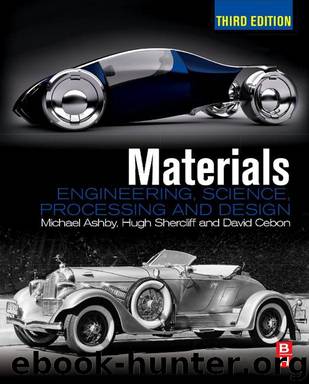Materials by Michael F. Ashby & Hugh Shercliff & David Cebon

Author:Michael F. Ashby & Hugh Shercliff & David Cebon
Language: eng
Format: epub
ISBN: 9780080982816
Publisher: Elsevier Science
Published: 2014-02-01T16:00:00+00:00
Figure 14.20 A piezoelectric material has non-symmetrically distributed charge, giving it a natural dipole moment. The surface charge associated with this is neutralized by pick-up of ions, but if it is deformed, as at (b), the dipole moment changes, and the surfaces become charged. The inverse is also true: a field induces a change of shape, the basis of piezoelectric actuation, as at (c).
A strain, then, induces an electric field in a piezoelectric material. The inverse is also true: a field induces a strain. The field pulls the positive ions and pushes the negative ones, changing their spacing and so changing the shape of the crystal (Figure 14.20(c)). If a small strain produces a large field, then a large field will produce only a very small strain. But the strain is a linear function of field, allowing extremely precise, if small, displacements, used for positioning and actuation at the sub-micron scale.
Piezoelectric materials respond to a change in electric field faster than most materials respond to a stimulus of this or any other kind. Put them in a megahertz field and they respond with microsecond precision. That opens up many applications, some described later in this chapter. In particular, it opens up the world of ultrasonics—sound waves with frequencies starting at the upper limit of the human ear, 20 kHz, on up to 20,000 kHz and above.
Download
This site does not store any files on its server. We only index and link to content provided by other sites. Please contact the content providers to delete copyright contents if any and email us, we'll remove relevant links or contents immediately.
| Automotive | Engineering |
| Transportation |
Whiskies Galore by Ian Buxton(41533)
Introduction to Aircraft Design (Cambridge Aerospace Series) by John P. Fielding(32891)
Small Unmanned Fixed-wing Aircraft Design by Andrew J. Keane Andras Sobester James P. Scanlan & András Sóbester & James P. Scanlan(32576)
Craft Beer for the Homebrewer by Michael Agnew(17936)
Turbulence by E. J. Noyes(7704)
The Complete Stick Figure Physics Tutorials by Allen Sarah(7144)
Kaplan MCAT General Chemistry Review by Kaplan(6601)
The Thirst by Nesbo Jo(6442)
Bad Blood by John Carreyrou(6279)
Modelling of Convective Heat and Mass Transfer in Rotating Flows by Igor V. Shevchuk(6227)
Learning SQL by Alan Beaulieu(6039)
Weapons of Math Destruction by Cathy O'Neil(5835)
Man-made Catastrophes and Risk Information Concealment by Dmitry Chernov & Didier Sornette(5654)
Digital Minimalism by Cal Newport;(5394)
Life 3.0: Being Human in the Age of Artificial Intelligence by Tegmark Max(5192)
iGen by Jean M. Twenge(5164)
Secrets of Antigravity Propulsion: Tesla, UFOs, and Classified Aerospace Technology by Ph.D. Paul A. Laviolette(4997)
Design of Trajectory Optimization Approach for Space Maneuver Vehicle Skip Entry Problems by Runqi Chai & Al Savvaris & Antonios Tsourdos & Senchun Chai(4845)
Electronic Devices & Circuits by Jacob Millman & Christos C. Halkias(4751)
